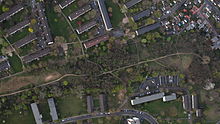Dune fir bush
The Tannenbusch dune is an inland dune and has been a seven-hectare nature reserve in the Tannenbusch district of Bonn since 1989 . In 2009 the regulation was renewed.
The dune was formed a good 10,000 years ago at the end of the last ice age. At that time, winds blew the sand of the Rhine here and piled up the chain of dunes. Originally it was 600 meters wide and 8 kilometers long. During the period under French occupation from 1794, mass graves were laid in the Tannenbusch dune. At the beginning of the 19th century, the area was then fenced and planted to prevent the sand from being blown onto the surrounding fields. The dune surrounds the Tannenbusch HICOG settlement that was built in the early 1950s on two sides .
vegetation
The dry sand grass with its drought-resistant and small-sized grasses and herbs grows on the dunes . The plants of the dune that are under nature protection include the purple flowering sand vetch and the silver grass .
Web links
- Nature reserve "Düne Tannenbusch" in the specialist information system of the State Office for Nature, Environment and Consumer Protection in North Rhine-Westphalia
Individual evidence
- ↑ Dune Tannenbusch. In: nature reserves. Federal city of Bonn, December 16, 2014, accessed on March 1, 2017 .
- ↑ Regulatory authority ordinance on the nature reserve "Düne Tannenbusch", district Tannenbusch, Federal City of Bonn. (PDF) In: Official Journal. Federal City of Bonn, December 2, 2009, pp. 1879 ff. , Accessed on March 1, 2017 .
- ↑ Dune nature reserve. In: parks and gardens. Federal city of Bonn, February 15, 2015, accessed on March 1, 2017 .
- ^ Werner Hesse: History of the city of Bonn during French rule, 1792-1815. Bonn 1879. pp. 89 f. , accessed January 18, 2016 .
- ↑ Holger Willcke: Dune Tannenbusch. In: General-Anzeiger (Bonn). Archived from the original on April 29, 2013 ; accessed on March 1, 2017 .
Coordinates: 50 ° 44 ′ 39 " N , 7 ° 3 ′ 43" E



